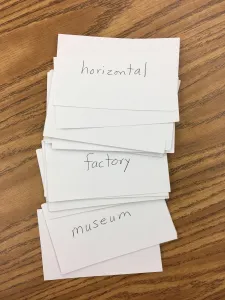A Can’t-Miss Vocabulary Activity
“How do you teach vocabulary to your ELs?” Darlyne de Hann asked this question at the end of her 5 October TESOL blog. One good answer is to ensure students get numerous opportunities to practice using the words you’re teaching. This helps students build a large vocabulary, a key to good reading. The vocabulary review activity I describe in this post can be used with English learners of all ages and in all subject areas. It’s low fuss, minimal prep, and students, not the teacher, do most of the work during the activity. What’s not to like about that?
To begin, prepare a list of words for review. If your students have devices, you can use an online flashcard program like Quizlet. If you want to stick to old school methods, simply use index cards with a word written on each card like the ones pictured.
Prereaders can use picture word cards. Before you launch the activity, demonstrate the procedure with a volunteer student partner. Put the students in pairs and give 5–10 cards to each student. Designate one partner in each pair as the rotating partner. Students then explain each word to their partners without saying it, trying to get them to guess the words. A typical exchange might go like this:
Student A: We eat it. It’s red and round.
Student B: Apple?
Student A: No, it’s small. It has little black things on the outside.
Student B: Strawberry?
Student A: Right!

And so on. When two partners have guessed all their words or when a set amount of time (e.g., 3 minutes) has elapsed (whichever comes first), one student from each pair rotates to another partner. I’d recommend three to five rotations so students get practice explaining their words to several different partners, getting better with each rotation. Every student also gets practice listening to the description of many different words because each new partner has a different vocabulary set. Customize the card decks by taking words out of the decks as students master them and adding other words as new content is studied.
This is a true information gap activity because partners don’t know which word will be described to them. Because it’s done in pairs, it also provides maximum speaking and listening opportunities. For large classes, put students into groups of four and give a card deck of 40 words to each group. Each student in the group is designated a letter A–-D. The rotations go like this:
1st rotation: A talks with B and C talks with D
2nd rotation: A-C and B-D
3rd rotation: A-D and B-C
A class of 36 high school students, for example, would need nine card decks of 40 words each. That’s 360 cards, but they can be used over and over again with different students.
I’ve used this activity with English learners from second grade to graduate school. As I circulate and listen to the student pairs during this activity, I’ve never failed to gain insights into students’ understanding (and misunderstanding!) of key vocabulary. This gives me valuable feedback to share with everyone during the activity wrap-up. For example:
- “I noticed many people were confusing study with learn. Let’s talk about the difference between these two words.”
- “This word gave lots of people difficulty. Let’s practice saying it correctly. Repeat: Immigrant.”
- “I thought you’d have trouble with migrate, but everybody easily described and guessed it. Why do you think so?”
Vocabulary review activities like the one I’ve just described are an important part of teaching academic vocabulary because they make students’ learning stick. It takes class time, but it’s time well spent.

About the author
Barbara Gottschalk
Barbara Gottschalk is a veteran educator. She has taught English language learners from first graders to graduate students in five states in three very different parts of the United States plus Japan. Gottschalk has written many successful grants and served as a grant reviewer for TESOL, the National Education Association, and the U.S. Department of Education's Office of English Language Acquisition. She is the author of "Get Money for Your Classroom: Easy Grant Writing Ideas That Work" and "Dispelling Misconceptions About English Language Learners: Research-Based Ways to Improve Instruction."